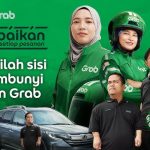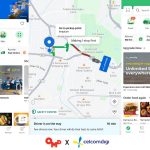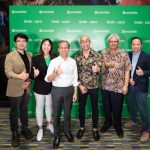In order to find the world’s top marketer, The World Federation of Advertisers (WFA) is partnering with The Drum for the Global Marketer of the Year award 2019.
The shortlist for this year’s award features heads of marketing from L’Oreal, Proctor & Gamble, Burger King, Diageo, Johnson & Johnson and Grab. Votes are now open to the industry and the WFA caught up with nominee Cheryl Goh, Grab’s group vice president of marketing and founding chief marketing officer.
Goh believes marketers of the future need to be able to hold their ground in a room of economists and technologists. She says they need to truly understand economics and financials, as well as where technology is headed and how that will change the way businesses do things.
“Marketers need to really understand financials and in fact, they should even try their hand, at some point, at managing profit and loss (P&L). Looking at the marketing industry, I always wonder why are we not having more marketing leaders lead businesses as CEOs. I feel that’s something that could change at Grab,” she explains.
“A lot of our marketing leaders are actually country heads today. So I think, there is a lot of opportunity for marketers to understand business and financials and P&L better, so that they can learn it.”
She continues: “They deserve a right and a seat at the table to make such decisions. So for me, I think my team should understand financials. They should understand how a P&L works, and they should understand business goals because, I mean, fundamentally, that’s why marketing exists. We exist to help companies achieve their business objectives.”
In addition, Goh says marketers also need to understand the technology and how things like automation and machine learning are going to change some level of decision making when it comes to marketing.
For example, they should ask themselves who should they reach out to, how much should they pay for certain kind of users from a performance marketing or from a customer acquisition cost point of view?
“When this person becomes part of the Grab platform, what are the best services that I should serve to him? So, I think over time, marketers also need to understand the technology and how all of that will change our approach towards marketing to a user,” she explains.
“You used to be you do one ad and buy a broad-based like television, everybody sees the same thing. Today, it’s highly more personalized and more relevant based on various signals.”
Grab, which aspires to become a super app, has since expanded from its core offering of ride-sharing to allowing users to book everything from food delivery to at-home beauticians as well as manage subscription, read news and pay for goods.
For Goh, she says her most important role, as a marketer now is to advance the brand equity and trust of Grab because those are very crucial for executing a super app strategy. She believes that if consumers trust Grab, they will continue to use the various services that the platform has introduced.
In order to do that successfully, she stresses that Grab needs to really go beyond just communications and branding as a team by becoming true guardians of the customer experience.
For example, for a brand that wants to be seen as trustworthy, they will need to be quick and accurate when addressing their customers’ complaints, she says.
That is why Goh’s marketing team recently took over any customer experience and customer service complaints on all social media channels because not only Grab want to be responsive to the issues, it also wants to turn those issues into moments of delight.
“I think, beyond just marketing, we have to think very hard about the customer experience. Another example is across the region, there are a lot of now privacy concerns. So, as marketers, we have to think very deeply and to use things like personalization and intelligence when it comes to our marketing communication tools,” explains Goh.
“We need to serve the right information to the right customer at the right time to protect their experience. So, I think what’s changed for us is that our role is one where we have had to adapt to the fact that what we really need to do for the Grab brand is to continue to build brand equity and trust.”
In the face of digital disruption and a changing agency landscape, Goh is future-proofing her marketing team by ensuring they stay close to business by understanding what are the current business goals and help achieve them.
“Depending on the business, our role as marketers change. For example, if you think about the early days of our transport business. When nobody was using Grab or any ride-hailing service, the most important thing for Grab or for the marketing team was to make sure that we can get everyone to try it, at least, for the first time to drive usage and growth,” she explains.
“That is how we measure ourselves, how do we continue to drive monthly active users, how do we continue to drive app downloads? But of course, as the business matured, the transport business matured and became sustainable, what became more important for us to focus on was things like retention and acquiring high-quality users that have positive lifetime value.”
She continues: “Then, today, across all of South East Asia, e-hailing regulations are coming into play, and marketing’s role is more about working with regulators and also communicating to the public so that they know about the various safety features that we’ve already put into place, things like selfie verification, telematics, insurance, emergency button and all of that.”
The platform launched its advertising arm called GrabAds in 2018 to provide brands with an omnichannel platform to reach commuters and provide additional revenue for Grab’s drivers, who will carry advertisements from brands on tablets inside their cars and emblazoned outside their cars.
It also wants to use GrabAds to work with brands and media partners to carry personalised ads, content and experiences, and generate mass awareness and create bespoke experiences for commuters.
Looking ahead, Goh says advertisers can look at Grab as a way to become contextually relevant in their customers’ lives. For example, an F&B company can advertise to a user that is on their ride home in a Grab car. On their ride home, the user will be able to see an ad and order food from the F&B company.
“Through Grab food delivery, we can even ensure that the pizza arrives at your doorstep as they’re getting home. So, I think, one great opportunity is we’re very contextual. We can bridge that online and offline experience,” explains Goh.
“We also have a lot of rewarded ad units that drive views on conversion because we have things like GrabRewards. We’re able to tell a lot of contextual things about our customers.”
She adds: “It’s very relevant. So I think, for advertisers, there are a lot of opportunities to be more relevant and to explore different types of ways of advertising that maybe combine the offline and online elements.”
source: https://www.thedrum.com/
MARKETING Magazine is not responsible for the content of external sites.











